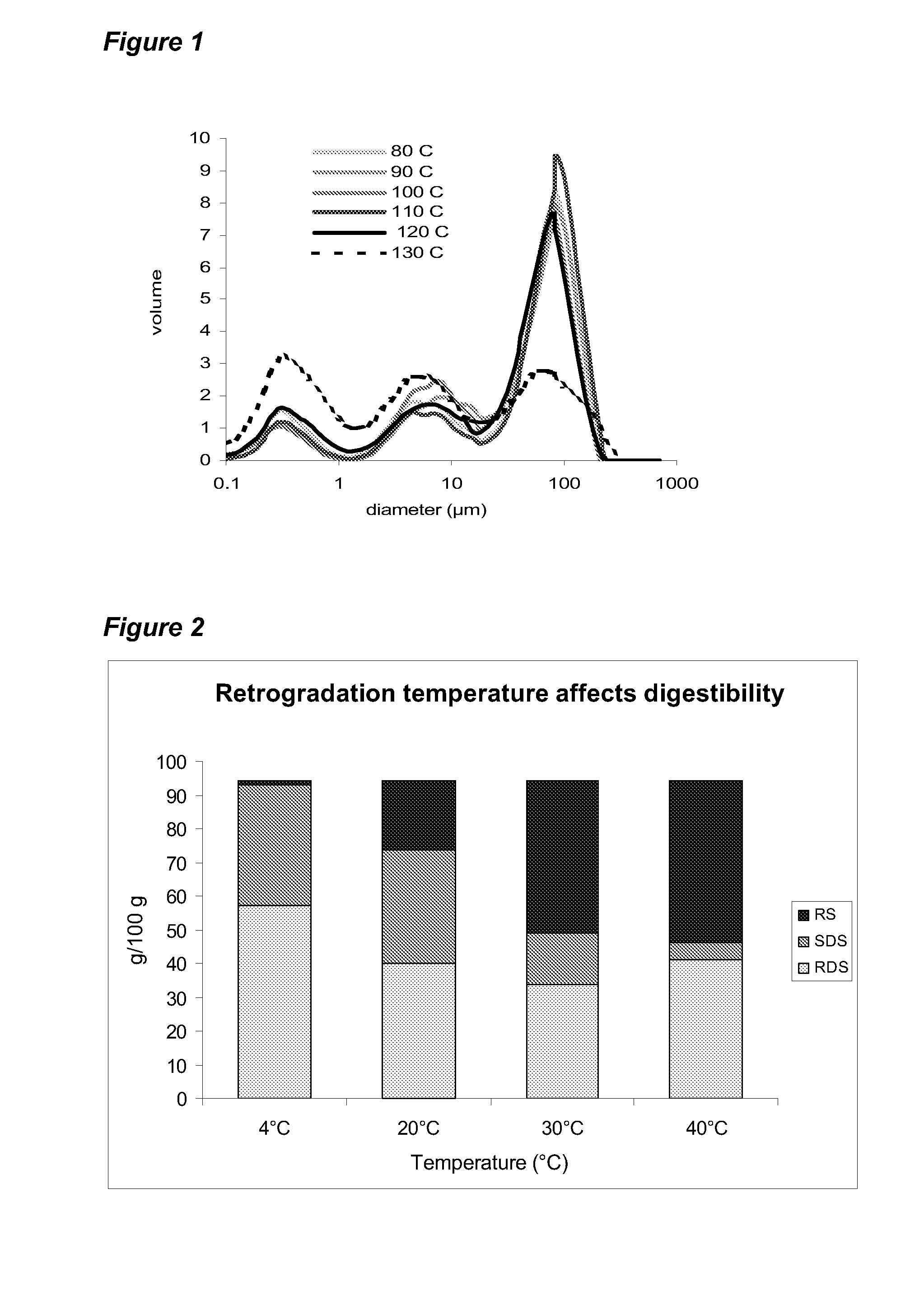Process for producing slowly digestible starch
a technology process, which is applied in the field of slowly digestible starch production, can solve the problems of slow digestible starch content, unattractive product, and insufficient capacity of diabetics to increase insulin concentrations in blood,
- Summary
- Abstract
- Description
- Claims
- Application Information
AI Technical Summary
Benefits of technology
Problems solved by technology
Method used
Image
Examples
example 1
[0063]Actistar, purchased from Cerestar, was suspended in demineralised water (14.7% (m / m)). The suspension was heated for 5 min at 80, 90, 100, 110, 120 or 130° C. in an oil bath and then cooled to room temperature with running tap water. 24 hrs (storage at 20° C.) after this heat treatment, the RDS, SDS and RS content and the particle size distribution were measured. The RDS, SDS and RS contents as determined with the Englyst method are given in Table 1 below, Values are expressed as percentage of the weighed powder; i.e. in g / 100 g “as is”, and expressed as mean±SEM (n=3). As the total weight of the Actistar includes 5.7 wt. % of non-starch components (water, protein and ash), the amounts total to 94.3 wt. %.
TABLE 1TreatmentRapidlySlowlyResistanttemperaturedigestibledigestiblestarch(° C.)starch (g / 100 g)starch (g / 100 g)(g / 100 g)8028.6 ± 2.010.4 ± 0.955.3 ± 2.39032.9 ± 2.313.8 ± 2.247.6 ± 4.510037.1 ± 3.516.3 ± 3.640.9 ± 6.811040.3 ± 1.025.6 ± 5.428.4 ± 5.912043.2 ± 1.932.4 ± 4.91...
example 2
[0064]Following the procedure of Example 1, Actistar was heated at 124° C. for 4 min at three different concentrations: 4, 8 and 15 wt. % (m / m). At each concentration, cooling was done either slowly (on air) or rapidly (using ice water). The RDS, SDS and RS contents are given in Table 2 below.
TABLE 24 wt.4 wt.8 wt.8 wt. %,15 wt.15 wt. %,%, slow%, rapid%, slowrapid% slowrapidRDS504942393335SDS72211361638RS372341194520(NDS)
[0065]Table 2 shows that rapid cooling leads to a drastic increase in SDS content, and that more concentrated suspensions have a higher SDS content that less concentrated suspensions. The particle size distribution shifts to lower sizes with rapid cooling, especially in more concentrated suspensions.
example 3
[0066]Following the procedure of Example 1, Actistar was heated at 124° C. for 4 min at 6 wt. %. Cooling was done according to four different modes: (a) slowly (on air) to room temperature, (b) slowly to 30° C. and then fast to room temperature in an ice water bath, (c) slowly to 40° C. and then fast to room temperature in an ice water bath, and (d) fast to room temperature in an ice water bath. The RDS, SDS and RS contents are given in Table 3 below.
TABLE 3(a)(b) slow / rapid(c) slow / rapid(d)slow30° C.40° C.rapidRDS44484238SDS11193340RS (NDS)39271916
[0067]Table 3 confirms that rapid cooling leads to a drastic increase in SDS content, and that especially the range between 30 and 40° C. is important. The particle size distribution shifts to lower sizes with rapid cooling, and only rapid cooling down from 40° C. and rapid cooling over the whole range produces more than 95% of particles below 12 μm.
PUM
| Property | Measurement | Unit |
|---|---|---|
| Temperature | aaaaa | aaaaa |
| Temperature | aaaaa | aaaaa |
| Temperature | aaaaa | aaaaa |
Abstract
Description
Claims
Application Information
 Login to View More
Login to View More - R&D
- Intellectual Property
- Life Sciences
- Materials
- Tech Scout
- Unparalleled Data Quality
- Higher Quality Content
- 60% Fewer Hallucinations
Browse by: Latest US Patents, China's latest patents, Technical Efficacy Thesaurus, Application Domain, Technology Topic, Popular Technical Reports.
© 2025 PatSnap. All rights reserved.Legal|Privacy policy|Modern Slavery Act Transparency Statement|Sitemap|About US| Contact US: help@patsnap.com

